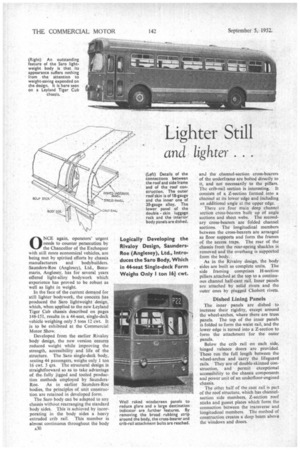, Lighter Still
Page 32

Page 33

If you've noticed an error in this article please click here to report it so we can fix it.
and lighter . .
0 NCE again, operators' urgent needs to counter persecution by the Chancellor of the Exchequer with still more economical vehicles, are being met by spirited efforts by chassis manufacturers and bodybuilders. Saunders-Roe (Anglesey), Ltd., Beaumaris, Anglesey, has for several years offered light-alloy bodywork which experience has proved to be robust as well as light in weight.
In the face of the current demand for still lighter bodywork, the concern has produced the Saro lightweight design, which, when applied to the new Leyland Tiger Cub chassis described on pages 148-151, results in a 44-seat, single-deck vehicle weighing only 5 tons 12 cwt. It is to be exhibited at the Commercial Motor Show.
Developed from the earlier Rivaloy body design, the new version ensures reduced weight while improving the strength, accessibility and life of the structure. The Saro single-deck body, seating 44 passengers, weighs only 1 ton 16 cwt. 3 qrs. The structural design is straightforward so as to take advantage of the. fully jigged and tooled production methods employed by SaundersRoe. As in earlier Saunders-Roe bodies, the principles of unit construction are retained in developed form.
The Saro body can be adapted to any chassis without rearranging the standard body sides. This is achieved by incorporating in the body sides a heavy extruded crib rail. This member is almost continuous throughout the body A30 and the channel-section cross-bearers of the underframe arc bolted directly to it, and not necessarily to the pillars. The crib-rail section is interesting. It consists of a Z-section formed into a channel at its lower edge and including an additional angle at the upper edge.
There are four main deep channel section cross-bearers built up of angle sections and sheet webs. The secondary cross-bearers are folded channel sections. The longitudinal members between the cross-bearers are arranged as floor supports and form the frames of the access traps. The rear of the chassis from the rear-spring shackles is removed and the overhang is supported from the body.
As in the Rivaloy design, the body sides are built as complete units. The side framing comprises H-section pillars attached at the top to a continuous channel half-cant rail. Inner panels are attached by solid rivets and the outer ones by plugged Chobert rivets.
Dished Lining Panels
The inner panels are dished to increase their rigidity, except around the wheel-arches, where there are truss panels. The top of the inner panels is folded to form the waist rail, and the lower edge is turned into a Z-section to form the attachment for the outer panels.
Below the crib rail on each side, hinged valance doors are provided. These run the full length between the wheel-arches and carry the lifeguard rails. They are of double-skinned construction, and permit exceptional accessibility to the chassis components and power unit of an undertloor-engined chassis.
The other half of the cant rail is part of the roof structure, which has channelsection side members, Z-section roof sticks and gusset plates which form the connection between the transverse and longitudinal members. The method of construction creates a deep beam above the windows and doors.
Body assembly and maintenance have been greatly facilitated as a result of the development work undertaken. AU the main units are bolted together,, and to speed assembly ,the body is composed of eight units instead of six as in the Ri valoy.
These are the floor, two sides, roof, front panelling, rear panelling, front canopy and entrance unit. Correct alignment of doors is ensured by introducing the door into the body as a separate unit. The separation of the front panelling and canopy avoids. difficulties in assembling.
Normally, access to all bolts is through the interior window finishers, which are held in position by light straps. Cover plates in the inner roof skin provide access to the roof rear unit and roof front canopy connections. and others perform a similar function below the waist level A broad plated rubbing strake running round the entire body on the outside is readily removed for access to the cross-bearer and crib member connecting bolts. Anchor nuts are fitted in the appropriate positions in each unit, so that, if necessary, any unit which becomes damaged can be removed and a replacement unit fitted without disturbing the entire structure.
Full Specification
Although light weight has been the desiglier's prime objective in this body, the specification is in no way skimped. A Glider-type entrance door, 2 ft. 8 ins. wide, is situated opposite the driver's cab, which has a full-height bulkhead behind. Another partition is provided behind the door. Six Rawlings Duovent double top-sliding windows are fitted on each side of the body in addition to three Airvac roof ventilators, and air intakes and outlets in the front panelling.
The main floor is level throughout, apart from a 4i-in. ramp towards the
entrance. This has made possible a reduction in the number of steps to two, each of 101 ins.; whilst the step from the ground is just over 1 ft. Entry into the vehicle should, therefore, be particularly easy.
Good appearance has not been overlooked. In fact, the combination of low weight good exterior appearance and fine interior finish are unusual in a body of such essentially practical merit.
The principles of weight-saving in evidence in the Sara single-deck, body have already been seen in the doubledeck body built by Saunders-Roe, At the Commercial Motor Show, a new version of this design, a Guy doubledecker for Birmingham Corporation, will be displayed.
















































































